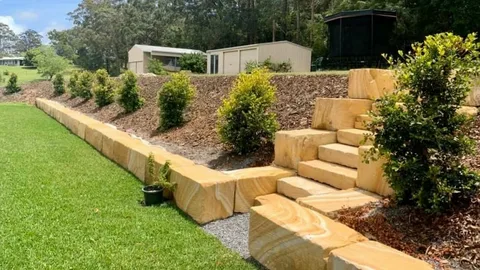Building a Sandstone Retaining Walls Brisbane offers aesthetic and practical benefits for outdoor spaces. Sandstone is renowned for its durability and natural appeal, making it a popular choice in Brisbane’s landscape designs. This guide will provide a detailed, step-by-step process to help navigate through the various stages of construction. Each step will be clearly outlined, from site assessment to finishing touches. Considerations like local regulations, suitable materials, and necessary tools will be discussed. This guide will help ensure a successful project that enhances your property’s value and appearance.
Understanding Local Regulations OF sandstone retain walls Brisbane
Understanding Brisbane’s building codes is essential before commencing any construction. Regulations can differ based on the retaining wall’s height and location. Consulting local authorities is necessary to ensure compliance with all relevant guidelines. Specific permits might be required, especially for taller or more complex structures. Ignoring these regulations could result in legal complications and potential fines.
Understanding zoning laws and property boundaries will also prevent future disputes with neighbours. Detailed knowledge of local standards will guide the project, ensuring it meets safety and legal requirements. Always verify if any heritage or environmental restrictions could affect the construction.
Planning and Designing the sandstone retaining walls in Brisbane
When embarking on a construction project, the first and most critical step is assessing the site conditions. This involves a meticulous evaluation of several factors, such as soil type, drainage, and the slope of the land. Understanding the soil type is vital as it impacts the foundation’s stability and drainage capacity, determining how water will move around or away from your structure. You must also consider the slope of the land, as it can affect the wall’s stability and drainage management.
Once the site conditions are evaluated, you can move on to the design phase, which involves careful consideration of the wall’s height and length and the load it needs to support. The height and length of the wall are crucial to its structural integrity, as taller and longer walls require more robust support mechanisms. The load that the wall needs to support includes not only the weight of the structure itself but also any additional forces, such as wind pressure or the weight of retained soil.
Accurate measurements play a critical role in this process. This includes precise dimensions calculations and ensuring all design elements are feasible within the given space. It’s important to double-check all measurements and design elements to avoid costly mistakes and ensure the safety and stability of the finished structure. Take your time to plan meticulously, as a well-thought-out plan sets the foundation for a successful build and helps anticipate any potential issues during construction. Thorough planning contributes to the building process’s efficiency and guarantees a long-lasting and stable structure.
Choosing the Right Stone Retaining Wall Brisbane
Selecting the appropriate Stone Retaining Wall Brisbane ensures durability and visual appeal. Various types of sandstone blocks, boulders, and tiles are available, each offering distinct characteristics. When choosing sandstone, consider factors like texture, colour, and weather resistance to suit Brisbane’s climate. It’s advisable to visit a reputable supplier who can provide expert guidance on the best sandstone options for the specific requirements of your project. Ensure the chosen sandstone meets quality standards to withstand the outdoor environment effectively. This selection will contribute significantly to the longevity and stability of the retaining wall.
Gathering Necessary Tools and Materials OF sandstone retain wall Brisbane
Gathering the right tools and materials is vital for a smooth construction process. Essential tools include a spirit level, shovel, wheelbarrow, and a masonry saw. Other helpful items might be a tape measure, a rubber mallet, and a chisel for sandstone shaping. The materials list typically includes sandstone blocks, gravel for the base, and geogrid for reinforcement. Having construction adhesive and mortar ready can also be beneficial. Ensure the tools are in good working condition and materials meet quality standards to avoid any interruptions during the building process.
Preparing the Site of the stone retaining wall in Brisbane
Begin by clearing the designated area of debris and vegetation to create a clean workspace. Use stakes and string to outline the precise layout and dimensions of the retaining wall. This helps ensure that the wall is built accurately according to the plan. Excavate the site to the required depth for the base, which should be more profound than the frost line, to prevent shifting. Compact the soil to create a solid foundation. If drainage is a concern, consider installing a drainage pipe or gravel at the base to prevent water accumulation. Proper site preparation is crucial for a stable and long-lasting retaining wall.
Laying the Foundation OFstone retain wall Brisbane
A strong foundation is the key to a durable retaining wall. Start by excavating a broad and deep trench to support the first layer of sandstone blocks. This trench should be filled with compacted gravel, ensuring stability and adequate drainage. Lay a geotextile fabric over the gravel to prevent soil from mixing in, which can compromise the base. Carefully place the first course of sandstone blocks on top of the gravel, ensuring they are level and securely positioned. Use a spirit level to verify accuracy. Properly aligned and levelled stones in the foundation will set the stage for a stable and visually appealing retaining wall.
Building the First Course of stone retain wall Brisbane
Begin laying the first layer of sandstone blocks within the prepared trench. Ensure each stone is level using a spirit level, adjusting as necessary. This foundational layer must be perfectly horizontal and stable to support subsequent layers. Place the rocks together to minimise gaps, enhancing the wall’s strength. Verify that the stones are properly aligned and maintain a consistent height throughout the first course. Use a rubber mallet to gently tap the stones into place, ensuring a snug fit. Accurate placement of this initial layer is critical in establishing the base for the entire retaining wall structure.
Continuing to Build Up the stone retaining wall in Brisbane
As construction progresses, ensure that the joints between sandstone blocks are staggered for increased structural integrity. This staggered pattern, known as a running bond, helps distribute the load more evenly across the wall. Use a spirit level to check for alignment and maintain a consistent height. Any deviations should be corrected immediately to prevent future issues.
Regularly backfill behind the wall with gravel to provide necessary drainage and support. Compact the backfill material properly to avoid settlement. Applying a construction adhesive or mortar layer between the stones can further stabilise the wall. This meticulous approach will ensure the retaining wall remains robust and visually appealing.
Securing the StructureOF stone retaining wall in Brisbane
Reinforcing the structure with geogrid is essential for added stability. Install the geogrid at regular intervals as specified in your design plan, anchoring it securely into the backfill material. This reinforcement method helps to distribute the load and prevents the wall from leaning. Backfill the area behind the wall with gravel, ensuring it is adequately compacted to provide additional support.
Continue to build up the wall, incorporating the geogrid as required. Proper drainage measures, such as installing perforated pipes or creating weep holes, will help to manage water flow and reduce pressure on the wall. These steps are crucial to maintain the structural integrity of the sandstone retaining wall.
Finishing Touches OF stone retain wall Brisbane
Adding the final touches enhances the visual appeal and functionality of the sandstone retaining wall. Cap the wall with flat stones to create a finished look. Choose caps that complement the colour and texture of the sandstone. Incorporate landscaping elements, such as native plants and flowers, to soften the wall’s appearance and blend it with the natural surroundings.
Consider installing outdoor lighting to highlight the wall during the evening, providing both aesthetics and safety. Applying a sealant to the sandstone can protect it from weathering and prolong its lifespan. Small decorative features like garden ornaments or water features can also be added to create a more personalised and engaging outdoor space.
Maintenance Tips for Longevity OF stone retain wall Brisbane
Regular inspections help detect early signs of wear or damage, allowing for prompt repairs. Clean the wall periodically to remove dirt, algae, and moss, which can retain moisture and cause deterioration. Use a gentle brush and mild detergent to avoid scratching the sandstone surface. Reapply sealant every few years to protect against weathering and water infiltration.
Check for loose or shifted stones and reposition them to maintain stability. Ensure drainage systems are functioning correctly to prevent water build-up behind the wall. Address erosion issues promptly by reinforcing affected areas with additional gravel or vegetation.
CONCLUSION
Constructing a Sandstone Retaining Walls Brisbane is a rewarding project that combines functionality with aesthetic appeal. The process involves detailed planning, careful selection of materials, and precision during the construction phase. Regular maintenance, including inspections and cleaning, is essential to preserve the wall’s condition and longevity. Proper drainage and reinforcement are critical components to prevent structural issues over time. Adhering to local regulations and employing quality craftsmanship results in a durable, attractive retaining wall that enhances any outdoor space. This guide provides the steps to achieve a successful build, ensuring the sandstone retaining wall remains a standout feature in the landscape.
FAQS
Q: Do I need a permit to build a Sandstone Retaining Walls Brisbane?
A: Permits may be required depending on the wall’s height and location. It’s advisable to consult with local authorities for specific regulations by Sandstone Retaining Walls Brisbane
.
Q: How can I ensure my sandstone wall remains stable?
A: Ensuring proper drainage, using geogrid reinforcement, and conducting regular maintenance checks will help maintain stability.
Q: What type of sandstone is best for retaining walls in Brisbane?
A: High-quality, weather-resistant sandstone is recommended. Consulting with reputable suppliers can help identify the best options for local conditions.
Q: What are common issues with sandstone retaining walls?
A: Common issues include water accumulation, erosion, and shifting stones. Regular inspections and maintenance can mitigate these problems.



